Of Old Radios And Related Items--Published Monthly
Radio Row Then and Now
BY DOROTHY SCHECTER
Web Edition
America has been the victim of a triple tragedy of unimaginable proportions. Though the losses at New York's World Trade Center are the greatest, those at the Pentagon, and in a field in Pennsylvania are of equal significance. However, for many in the radio-collecting community, there is a direct link to the World Trade Center tragedy. It lies in the history of that lower Manhattan site, once the heart of Radio Row. In the following article, we reflect on that history and explore how radio has continued to be an active participant in the present tragic fate of a once thriving radio world. Perhaps this historical perspective will also help us to cope with the magnitude of the grief and loss that the area will always represent. (Editor)
September 11, 2001, will remain in our collective memories forever as a day of horror and grief unparalleled in American history. For the radio-collecting community, this tragedy has special poignance because of the location of the World Trade Center -- site of the once famous Radio Row, the main axis of which was Cortlandt St. Though other cities had similar centers of radio sales, according to Radio-Craft for September 1932, "There is no city in the world that has a Radio Row comparable to New York's Cortlandt St."
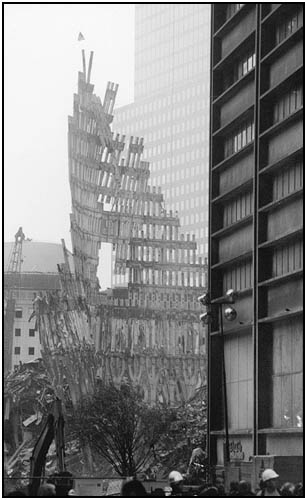
Atop the destruction, the flag still waves! (JVT photo)
In keeping with this piece of radio history, A.R.C. has run several articles over the years about Radio Row. Once again, we feel compelled to return to the subject as we receive e-mails and pick up newsgroup messages that reveal a nostalgia for those seemingly innocuous times before the 1960s when the World Trade Center replaced Radio Row. Remembering the past can sometimes assuage the sorrow of the present.
The Past
On our pages from time to time, older collectors have reminisced fondly about their forays into the treasures of Radio Row on the Saturday mornings of their youths. Alton DuBois (April 1991) found that the article about H. L. Schneck's 1920s store "City Radio" on Cortlandt St. (July 1990) triggered his own memories of visits there in the 1930s. In those times, even stores in the suburbs depended on Radio Row for their needs.
In the September 1998 A.R.C., photos provided by Francis Yonker gave us the opportunity to present a kind of photo essay on Radio Row. We were able to re-create a map and to walk you through the streets so laden with radio treasures. Ironically, that article begins, "Remember when the World Trade Center wasn't there?"
Thinking about the Yonker photos in the light of current events, Editor John Terrey was inspired to try to secure more old photos of the streets of Radio Row. At the New York Public Library, he found the photo on our cover and the two others on these pages (see print edition).
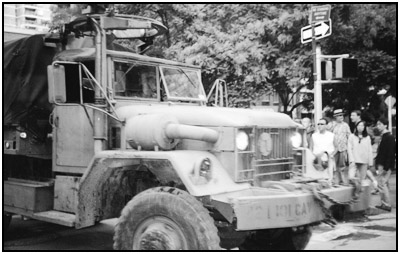
Instead of taxis and limos, military vehicles crowded the streets of lower Manhattan.
It was obvious from exchanges on the Internet that other collectors too needed to connect with those times when the world seemed a smaller and safer place. For example, A.R.C. subscriber Al Germond posted the following memory mixed with sadness, "Watching rescue workers sifting through the macabre rubble of the World Trade Center summons memories of that plot's previous existence as New York's Radio Row. ...I remember making occasional trips to Cortlandt St. forty years ago... It was an absolute paradise for any radio fiend."
Al also referred to The Old Timer's Bulletin, Spring 1966, which described the demolition of the last vestiges of Radio Row when 15 tons of miscellaneous parts from the Leotone Radio Corp. became rubble. Al wrote, "Out it went -- some of Manhattan's radio history accumulated since the turn of the century -- load after load hauled through the Holland Tunnel over to Jersey just like the tons of rubble today from the buildings that replaced Radio Row."
Doug Houston, who has contributed articles to A.R.C., also posted a memory of that transition time. On a business trip in the 1960s, he decided to visit the place that once had been for him a "weekly haunt." Getting off the subway at Cortlandt St., he found himself disoriented because he was "looking at a big hole in the ground where Radio Row had been." He describes it as "one of the sadder moments in my life!"
Messages from younger collectors indicate their sense of loss at never having known Radio Row, a place where crowds made the streets on a Saturday barely passable. Sidewalks were so cluttered with offerings of all kinds that shoppers thought themselves in some kind of radio utopia. One photo of sets outside a shop in the earlier mentioned Radio-Craft article tells it all -- a sign says, "Any set 25¢."
Radio Row was a happy place. We mourn with the rest of the country that its successor met such a terrible fate.
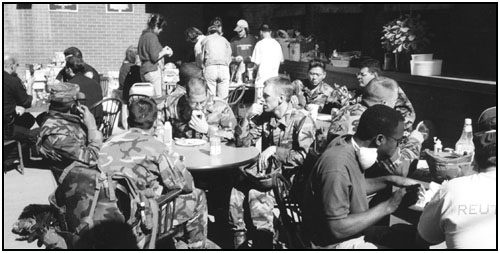
Relief workers take a well-deserved break at the Seamen's Church Institute, a few blocks from the disaster. (JVT photo)
The Present
"Tragic events like those of today make our little hobbies seem pretty irrelevant." This sentiment appearing on the Web recently reverberates with us all, and, of course, makes us stop to think about our priorities in life. However, collectors can also stop to take pride in radio's heroic role in times of tragedy. This time was no exception.
The news of Amateur Radio's participation in the rescue and cleanup operations at the World Trade Center was brought to our attention by A.R.C. contributing writer Will Jensby. Will referred to the story on the San Francisco Antique Radio Club (SFARC) Web site about fellow member Bart Lee's direct participation in rescue efforts as an Amateur Radio operator. Bart has also been an A.R.C. contributing writer and is well known as a frequent AWA presenter.
On September 11, Bart's law practice found him in New York where he happened to stay only 1.65 miles from "Ground Zero." He actually saw the third building go down.
Offering his Ham operator services immediately, Bart became the night-shift trick-chief as KV6LEE for the Red Cross operation. Bart worked 14 to 18 hour shifts for more than a week, but he spoke of his untiring fellow workers as the real heroes. As he modestly put it, "One does not 'rise to the occasion;' one sinks to one's level of training."
Why was Amateur Radio, certainly no longer first among modern commercial telecommunications systems, so vital in such an overwhelmingly difficult rescue operation? Because it was the only mode of communication totally available. Other services were either blocked by health and welfare telephone messages or physically destroyed. Cell phones, landlines, and Internet connections were either inoperative or intermittent. FCC legal injunctions preventing the use of Ham Radio from doing business or directly coordinating police and fire activities had to be lifted. As the SFARC article states, "...the usual concepts of Ham Radio being a mere tertiary communicatons application... were historically overturned forevermore!"
Of course, Bart and his group were far from alone. A perusal of the ARRL Letter on the Internet tells the story of an amazing volunteer effort, and the November 2001 QST covers this effort in detail. As of September 21, more than 350 Hams had volunteered over 5,000 work hours. Prepared with equipment for survival in "hazardous, war-like conditions," they came committed to work at least 30 hours after arrival in New York City.
The operation was described as a long-term effort with the schedule being filled on a day-by-day basis. The expectation was to continue the work until normal telecommunications could resume without disruption. As ARRL President Jim Haymie said in QST, "Never have I felt more strongly about what a great privilege it is to be part of the extraordinary global community of Amateur Radio."
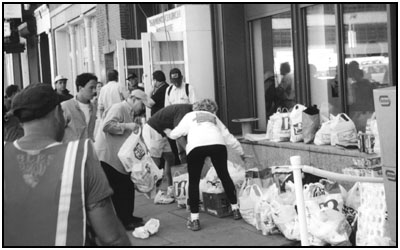
Receiving donated goods and food at the Seamen's Church Institute. (JVT photo)
Amateur Radio operators were not the only folks from our radio community who found themselves on old Radio Row terrain doing whatever they could to help. Our own editor John Terrey happened to have reason to be in New York on the weekend immediately following the event. He had the opportunity to volunteer with the Seamen's Church Institute a few blocks from the tragedy to distribute food to exhausted workers. No radio skills required, but organizational skills put him "in charge" for several long hours. A few of his photos of the devastation and of those trying to cope with it are shown here.
Perhaps the most striking images he carried away could not be captured on film. On the following Friday evening, he returned to the city when dusk was falling. The Manhattan streets were lined with lighted candles in windows, and outside fire stations were flowers and more candles. Everywhere in Union Sq. there were posters with photos of missing people. A few days could not equal the weeks of grueling work experienced by so many, but it was enough to leave a lifetime of impressions.
The Future
As recent events have shown, radio's value in times of crisis is indisputable. But, have we used it to maximum advantage in our now openly declared war against terrorism, as we did against Hitler or communism? On the New York Times Op-Ed page, September 20, 2001, columnist William Safire asks an interesting question: "Why is there no Radio Free Afghanistan broadcasting the truth about the consequences of harboring the headquarters of terrorism?" He points out that as the Taliban's Radio Shariot spews out hatred of America non-stop, "America is asleep at the microphone."
We have been violently awakened. Let's hope that Safire's call for an American signal in Afghanistan's five languages to spread the truth is established. Radio is invaluable in the kind of psychological warfare we will have to continue long after the guns are silent.
Another question of the future will no doubt be, "Do you remember where you were on September 11, 2001?" How often we've heard a similar question asked about Pearl Harbor or the assassination of President Kennedy. For the radio-collecting community, the question may conjure up a mental collage of the terrible image of the World Trade Center moments after impact juxtaposed with an old photo of Cortlandt St.
Still another question might be, "And what was your reaction when you first heard the news on September 11?" Did you think with Bruce Mager driving from New Jersey to his radio shop "Waves" near Penn Station and listening to Howard Stern that it was just a sick joke? Two days later, like his wife Charlotte, were you still finding it hard to believe, and were you thanking your lucky stars that the Holland Tunnel was closed when Bruce and so many other daily commuters reached it?
Since then, have you remembered the effects of other disasters on your life or your collections? Perhaps you were hit by the San Francisco earthquake (A.R.C., January 1990), or the Alaska earthquake on March 27, 1964, where the Alaska Amateur Radio operators handled more than 50,000 messages within and outside the disaster area. See the cancelled commemorative stamp on an envelope issued by the Anchorage Philatelic Society and reproduced here. Natural disasters can, of course, cause irreparable harm, but they seem to diminish in the harsh light of this man-created tragedy.
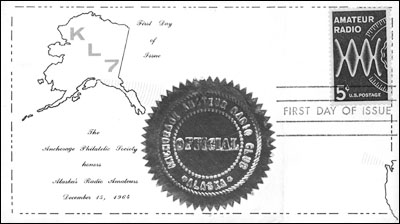
The First Day Cover for the stamp commemorating Amateur Radio's assistance after the 1964 Alaska earthquake. (R. Lyman Collection)
In so many ways, we are all connected forever to the events of September 11, some, sadly, on a very personal level, all as Americans, and all in the radio collecting community because of the place -- Radio Row, Cortlandt St., and the World Trade Center.
Photo credits: Percy L. Speer from Photographic Views of New York City, 1870s-1970s, used with permission of the Milstein Division of U.S. History, Local History, and Genealogy, The New York Public Library; and John V. Terrey.
References:
Adams, Mike. Antique Radio Classified. "Can your Collection Survive the Big One?" January 1990.
Antique Wireless Association. Old Timer's Bulletin, Spring 1966.
DuBois, Alton A., Jr. Antique Radio Classified, "More Cortlandt Street Memories," July, 1991.
Germond, Al; Doug Houston. New York Radio Message Board postings, September 13, and 16, 2001.
Hertzberg, Robert. Radio-Craft. "Radio a la Cortlandt Street!" September 1932.
Jackson, Dan. San Francisco Antique Radio Club Web site, September 15 and 24, 2001.
Lindquist, Rick and Diane Ortiz. "9/11/01: This is not a Test." QST, November 2001.
Schneck, Ed. Antique Radio Classified. "H.L. Schneck -- A Legend of Cortlandt Street," July 1990.
Yonker, Francis H. Antique Radio Classified. "Radio Row -- Cortlandt Street 1930-1970," September 1998.
(Dorothy Schecter, c/o A.R.C., P.O. Box 2, Carlisle, MA 01741)
9/11 Amateur Radio in Disaster Relief
By Bart Lee, KV6LEE
Web Edition
The following is Bart Lee's "private citizen's eyewitness report on Ham Radio's finest hour." We're grateful to Bart for sharing this firsthand experience with us. (Editor)
Within minutes of the terrorists' attack on the World Trade Center, Amateur Radio went on the air in disaster relief. A month later, I am left with a powerful sense of pride in how Amateur Radio volunteers stepped into the breach, took real personal risks, and put radio to work when all else failed. We learned all too much from this terrorism, but one of the good things was how much difference Amateur Radio can make for the good.
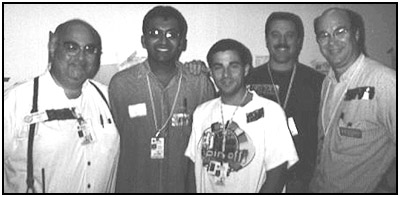
Bart Lee, left, and others provided communications for the Red Cross in the aftermath of the World Trade Center disaster.
The New York Radio Amateur Civil Emergency Service (RACES) net went up on the air within minutes of the disaster. D-Day Ham traffic that I monitored related to hospital utilization and out-of-state disaster response teams. The next day I volunteered at the Red Cross.
The communications chief, Jay Ferron, did a magnificent job getting Amateur Radio communications into each of a dozen Red Cross shelters and three Office of Emergency Management sites for 24 hours a day for nearly two straight weeks. Hams volunteered from all over the metropolitan area, and several states. (I happened to be visiting from California.) Westchester RACES supplied many trained and capable radio operators day in and day out, as did New Jersey.
As many as 100 or more Hams each day involved themselves on either the day shift or the night shift; I was night-shift trick-chief for the first week. Amateur Radio operators worked in "the hot zone" at unknown but real personal risk, and at many shelters. All put in long days and long nights insuring that traffic got through.
In the first several days, cell phones and landlines either simply did not work or were spotty at best. Vaunted high technology fell to earth, but Hams with their own radios and equipment stepped in for effective emergency communications. Some of the earliest traffic I personally handled at Red Cross headquarters was an emergency evacuation order, sent out on a handheld transceiver into a jury rigged Yagi antenna. There was all too much of that priority in the early days of this horrific event.
We never had too few volunteers, each of whom had trained himself (and herself) to do whatever it takes, and they did it. We had Hams from several countries helping as well -- Russia, India, Canada, and the Leeward Islands, stand out.
For the hot zone, we issued dust masks and special credentials, and everybody got (initially from me) a disaster-worker orientation, and later, a debriefing. The Red Cross transported the radio operators into and out of Manhattan from Brooklyn after transferring New York operations there on D-Day plus 4.
The shelters kept track of their clients, staff, security, etc. and Red Cross polled them regularly by Amateur Radio. Once telephones worked, that traffic came off the RACES net. Red Cross sent Multi-Disciplinary Outreach Teams into lower Manhattan around D-Day+8. They tried to communicate via cell phones, but only Amateur Radio worked reliably, at least at first.
The work was exhausting. After nine days, I turned my job over to my replacement, Brian Fernandez, K1BRF. I came home to California stunned by the terrorism, but proud of all the Americans I saw and worked with in New York, especially the Hams. 73.
Note: This report is not sponsored or authorized by the Red Cross; it is a private report on Amateur Radio.
(Bart Lee, 5595 Market St., Suite 1350, San Francisco, CA 94105-2825)
| [Free Sample] [Books, etc., For Sale] [Subscribe to A.R.C./Renew] [Classified Ads] [Auction Prices] [Event Calendar] [Links] [Home] [Issue Archives] [Book Reviews] [Subscription Information] [A.R.C. FAQ] URL = http://www.antiqueradio.com/Nov01_radiorow.html Copyright © 1996-2001 by John V. Terrey - For personal use only. Last revised: October 30, 2001. For Customer Assistance please contact ARC@antiqueradio.com or call (978) 371-0512 Pages designed/maintained by Wayward Fluffy Publications
Antique Radio Classified |